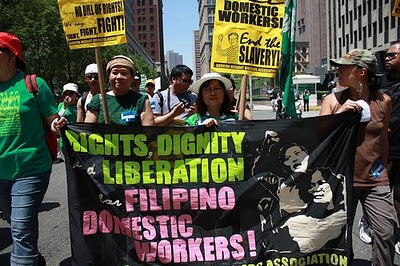Migration: a gender perspective

The benefits of migration in terms of economic development and country progress have been widely recognised both for sending and receiving countries, and at individual level mobility is an essential part of our lives today. This article tries to look at migration from a gender perspective, and shows some of the positive and negative impacts coming from Female Migration .
Setting the scene
Migration is no longer just a South-North phenomenon – because of more restrictive policies in the North and in an ever-connected world, many countries rely on the benefits of migration for their economies, which generates more South-South migration.OECD (2011), Tackling the Policy Challenges of Migration: Regulation, Integration, Development, Development Centre Studies, OECD Publishing, p. 20 Migrating to another country in the search for better life prospects is traditionally a male venture, although women increasingly migrate as well. Therefore to really understand the migration phenomenon, it is essential to include gender perspective and see the positive and negative effects on migrants’ families.

Some figures
- Between 1960 and 2005, the number of international migrants in the world doubled
- In 2005, about 190 million people (3 per cent of the world’s population) lived outside their country of origin
- Remittances amounting to over $200 billion a year
- The share of women in the world’s population of international migrants is about halfThe World Bank (2008), The International Migration of Women, Palgrave Macmillan, Washington, DC, p. 1
- The top regions of the world with the most women migrants are Oceania, Latin America and the Caribbean, Africa and the Soviet Union, whereas the lowest proportion of women migrants is the Middle EastThe World Bank (2008), The International Migration of Women, Palgrave Macmillan, Washington, DC, p. 2
Migration with a gender perspective
An interesting aspect to look at in the emigration process is what happens when women are left behind. Husbands who emigrate leave their wives to look after the household – traditionally a role held by men – in addition to looking after the well-being of their family.OECD (2011), Tackling the Policy Challenges of Migration: Regulation, Integration, Development, Development Centre Studies, OECD Publishing, p. 94 Remittances sent by their husbands allows the ma more flexible work schedule – in fact, women tend to spend most time on household management and child-rearing rather than on working to generate an income. Women then tend to also work in self-employment rather than in paid work.OECD (2011), Tackling the Policy Challenges of Migration: Regulation, Integration, Development, Development Centre Studies, OECD Publishing, p. 95 The positive effect there is that women become empowered in the sense that they have control over the household finances while their husband is away, therefore gaining more intra-household power.
There is however another phenomenon, that of women leaving their household behind and migrating to a richer country to care for children or the elderly in another family. Like men, women migrate both to support their families and to achieve their aspirations. But a woman leaving her family behind has a rather negative impact on any children staying in the country of origin of the woman – mainly affecting the areas like health, education, social relations and family cohesion. In particular, children left behind tend to experience emotional instability and poor educational achievement. In some cases it can even engender juvenile delinquency and have serious consequences for the social cohesion of an entire community.OECD (2011), Tackling the Policy Challenges of Migration: Regulation, Integration, Development, Development Centre Studies, OECD Publishing, p. 96
Regarding household expenditure patterns, it was found that in Mexico , households with female migrants spend a lot less on education than households without female migrants – which indicates that the sex of the migrant has an impact on the patterns of expenditure when receiving remittances.The World Bank (2008), The International Migration of Women, Palgrave Macmillan, Washington, DC, p. 7 Also, it is interesting to not only see a gender pattern in the way remittances are spent, but also a different pattern among female-headed households, depending on whether remittances received at international or internal. For example it was found that in Ghana , female-headed households receiving internal remittances spent a larger amount of money on Education for All and Category:Health, whereas female-headed households receiving international remittances spent less money on food and more money on durable goods such as housing and health. Finally, it was noted that when households receive Women migrants' remittances , there is less of the budget allocated to education, whereas when households receive remittances from a man, more budget is dedicated to education (this is explained by the fact that men overall spend less money on education than women, also if the children leave with the mother, less will be devoted to education expenditures also).The World Bank (2008), The International Migration of Women, Palgrave Macmillan, Washington, DC, p. 8
In terms of entering the labour market in Gender Equality in the United States of America of America, women migrants’ participation in the labour force is highly dependent on: the education level and the number of years spent in the United States. The number of children and the marital status are also key determinants (for example single women or women married to American men are the most likely to find work). These findings are confirmed by the country of origin of the migrant women, as female migrants from South Asia and the Women in the Middle East and North Women and African Economic Development (MENA) have a lower labour market participation rate than female migrants from Europe, Sub-Saharan Africa, the Caribbean and East Asia. These criteria also impact on wage levels for women migrants.
References
See Also
Other progress-related articles
- See [Wikigender Progress Series|Wikigender Progress Series]


